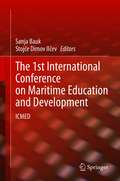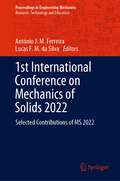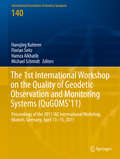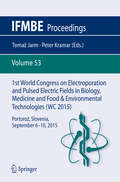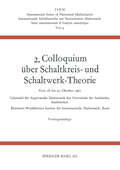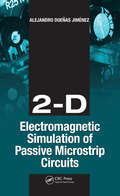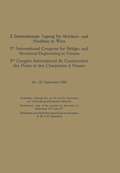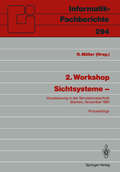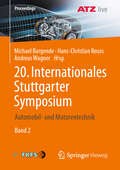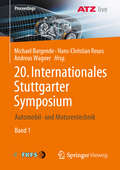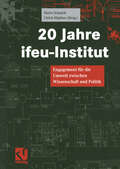- Table View
- List View
1D Semiconducting Hybrid Nanostructures: Synthesis and Applications in Gas Sensing and Optoelectronics
by Arvind Kumar Dinesh K. Aswal Nirav Joshi1D Semiconducting Hybrid Nanostructures In-depth discussion on the physics, chemistry, and engineering beneath the construction of 1D semiconducting hybrid materials 1D Semiconducting Hybrid Nanostructures: Synthesis and Applications in Gas Sensing and Optoelectronics provides breakthrough research developments and trends in a variety of 1D hybrid nanostructures for chemi-resistive gas sensors and optoelectronics applications, including recent investigations and developments regarding the innovative designing approaches, fabrications, and methods used to characterize these hybrid nanostructures. The text also includes the surface and interface properties of 1D hybrid semiconducting nanostructured materials, as well as their optimization for applications in gas sensing and optoelectronics. This book further addresses the different issues of sensitivity, selectivity, and operating temperature of gas sensors based on hybrid 1D nanostructures. Moreover, it covers the novel and additional functional optoelectronic properties that originate at the interface of 1D semiconducting nanostructures combined with other low dimensional materials. Some of the specific sample topics covered in this book include: Gas sensing and optoelectronic applications of one-dimensional semiconducting hybrid nanostructures, plus synthesis and gas sensing application of 1D semiconducting hybrid nanostructures Room temperature gas sensing properties of metal oxide nanowire/graphene hybrid structures and highly sensitive room temperature gas sensors based on organic-inorganic nanofibers Synthesis and applications of 1D hybrid tin oxide nanostructures and recent advances in semiconducting nanowires-based hybrid structures for solar application Types of semiconducting hybrid nanostructures for optoelectronic devices and hybrid 1D semiconducting ZnO/GaN nanostructures Thanks to its comprehensive coverage of the subject from highly qualified authors who have significant experience in the field, 1D Semiconducting Hybrid Nanostructures is a must-have reference for senior undergraduate and graduate students, professionals, researchers, in the field of semiconductor physics, materials science, surface science, and chemical engineering.
1D Semiconducting Hybrid Nanostructures: Synthesis and Applications in Gas Sensing and Optoelectronics
by Arvind Kumar Dinesh K. Aswal Nirav Joshi1D Semiconducting Hybrid Nanostructures In-depth discussion on the physics, chemistry, and engineering beneath the construction of 1D semiconducting hybrid materials 1D Semiconducting Hybrid Nanostructures: Synthesis and Applications in Gas Sensing and Optoelectronics provides breakthrough research developments and trends in a variety of 1D hybrid nanostructures for chemi-resistive gas sensors and optoelectronics applications, including recent investigations and developments regarding the innovative designing approaches, fabrications, and methods used to characterize these hybrid nanostructures. The text also includes the surface and interface properties of 1D hybrid semiconducting nanostructured materials, as well as their optimization for applications in gas sensing and optoelectronics. This book further addresses the different issues of sensitivity, selectivity, and operating temperature of gas sensors based on hybrid 1D nanostructures. Moreover, it covers the novel and additional functional optoelectronic properties that originate at the interface of 1D semiconducting nanostructures combined with other low dimensional materials. Some of the specific sample topics covered in this book include: Gas sensing and optoelectronic applications of one-dimensional semiconducting hybrid nanostructures, plus synthesis and gas sensing application of 1D semiconducting hybrid nanostructures Room temperature gas sensing properties of metal oxide nanowire/graphene hybrid structures and highly sensitive room temperature gas sensors based on organic-inorganic nanofibers Synthesis and applications of 1D hybrid tin oxide nanostructures and recent advances in semiconducting nanowires-based hybrid structures for solar application Types of semiconducting hybrid nanostructures for optoelectronic devices and hybrid 1D semiconducting ZnO/GaN nanostructures Thanks to its comprehensive coverage of the subject from highly qualified authors who have significant experience in the field, 1D Semiconducting Hybrid Nanostructures is a must-have reference for senior undergraduate and graduate students, professionals, researchers, in the field of semiconductor physics, materials science, surface science, and chemical engineering.
1st Global Conference on Biomedical Engineering & 9th Asian-Pacific Conference on Medical and Biological Engineering: October 9-12, 2014, Tainan, Taiwan (IFMBE Proceedings #47)
by Fong-Chin Su Shyh-Hau Wang Ming-Long YehThis volume presents the proceedings of the 9th Asian-Pacific Conference on Medical and Biological Engineering (APCMBE 2014). The proceedings address a broad spectrum of topics from Bioengineering and Biomedicine, like Biomaterials, Artificial Organs, Tissue Engineering, Nanobiotechnology and Nanomedicine, Biomedical Imaging, Bio MEMS, Biosignal Processing, Digital Medicine, BME Education. It helps medical and biological engineering professionals to interact and exchange their ideas and experiences.
1st International Conference on 3D Materials Science, 2012: Conference Proceedings (The Minerals, Metals & Materials Series)
Addressing a critical growth area in materials science, this volume features papers presented at the 2012 International Conference on 3D Materials Science, organized by The Minerals, Metals & Materials Society (TMS). With the top researchers in the world assessing the state-of-the-art within the various elements of three-dimensional materials science, this collection provides the premier forum for authoritative presentations on all aspects of the science, including characterization, visualization, quantitative analysis, modeling, and investigation of structure-property relationships of materials.
1st International Conference on Engineering Manufacture 2022: Selected Contributions of EM 2022 (Proceedings in Engineering Mechanics)
by Lucas F. M. da Silva Digavalli Ravi Kumar Maria de Fátima Reis Vaz Ricardo J. C. CarbasThis book focusses on additive manufacturing including many aspects, like vacuum assisted high pressure die casting, semi-solid metal casting, compressive and tensile forming processes, micro and nano machining, nanocomposite manufacturing, adhesive bonding, laser cutting and joining. Subtopics like modelling and optimization of manufacture processes, design for manufacturing strategies, development of new manufacturing technologies, design of novel manufacturing equipment, comparative case studies, cost and quality analysis, ecological aspects and destructive and non-destructive testing of manufactured components are also presented.The book provides a state of the art of engineering manufacture and also serves as a reference volume for researchers and graduate students using technological processes.This volume gathers selected contributions of the 1st International Conference on Engineering Manufacture 2022, held in Porto, Portugal, on May 5–6, 2022.
The 1st International Conference on Maritime Education and Development: ICMED
by Sanja Bauk Stojče Dimov IlčevThis book presents the proceedings of the 1st International Conference on Maritime Education and Development. The conference exchanges knowledge, experiences and ideas in the domain of maritime education and development, with the ultimate goal of generating new knowledge and implementing smart strategies and actions. Topics include the 4th Industrial Revolution (4IR); unmanned air/sea surface/underwater vehicles (UxV); the digital divide and Internet accessibility; digital infrastructure; IMO E-navigation strategy; smart-ship concept; automation and digitalization; cyber security; and maritime future. This proceedings pertains to researchers, academics, students, and professionals in the realm of maritime education and development.
1st International Conference on Mechanics of Solids 2022: Selected Contributions of MS 2022 (Proceedings in Engineering Mechanics)
by António J. M. Ferreira Lucas F. M. da SilvaThis book provides selected papers presented at the 1st International Conference on Mechanics of Solids, held in Porto, Portugal, November 3-4, 2022.The book focuses on the mechanics of deformable solids, dynamics of particles and rigid bodies. Topics like mechanical behaviour of materials, mechanics of composite materials, plasticity, fracture mechanics, and optimum design methods are covered. This volume provides the latest trends related to mechanics of solids and appeals to researchers and practitioners across the broad spectrum.
The 1st International Workshop on the Quality of Geodetic Observation and Monitoring Systems: Proceedings of the 2011 IAG International Workshop, Munich, Germany April 13–15, 2011 (International Association of Geodesy Symposia #140)
by Hansjörg Kutterer Florian Seitz Hamza Alkhatib Michael SchmidtThese proceedings contain 25 papers, which are the peer-reviewed versions of presentations made at the 1st International Workshop on the Quality of Geodetic Observation and Monitoring (QuGOMS’11), held 13 April to 15 April 2011 in Garching, Germany. The papers were drawn from five sessions which reflected the following topic areas: (1) Uncertainty Modeling of Geodetic Data, (2) Theoretical Studies on Combination Strategies and Parameter Estimation, (3) Recursive State-Space Filtering, (4) Sensor Networks and Multi Sensor Systems in Engineering Geodesy, (5) Multi-Mission Approaches With View to Physical Processes in the Earth System.
1st World Congress on Electroporation and Pulsed Electric Fields in Biology, Medicine and Food & Environmental Technologies: Portorož, Slovenia, September 6 –10, 2015 (IFMBE Proceedings #53)
by Tomaz Jarm Peter KramarThis volume presents the proceedings of the 1st World Congress on Electroporation and Pulsed Electric Fields in Biology, Medicine and Food & Environmental Technologies (WC2015). The congress took place in Portorož, Slovenia, during the week of September 6th to 10th, 2015. The scientific part of the Congress covered different aspects of electroporation and related technologies and included the following main topics: · Application of pulsed electric fields technology in food: challenges and opportunities· Electrical impedance measurement for assessment of electroporation yield· Electrochemistry and electroporation· Electroporation meets electrostimulation· Electrotechnologies for food and biomass treatment· Food and biotechnology applications· In vitro electroporation - basic mechanisms· Interfacial behaviour of lipid-assemblies, membranes and cells in electric fields· Irreversible electroporation in clinical use· Medical applications: electrochemotherapy· Medical applications: gene therapy· Non-electric field-based physical methods inducing cell poration and enhanced molecule transfer· Non-thermal plasmas for food safety, environmental applications and medical treatments· PEF for the food industry: fundamentals and applications· PEF process integration - complex process chains and process combinations in the food industry· Predictable animal models· Pulsed electric fields and electroporation technologies in bioeconomy· Veterinary medical applications
1V CMOS Gm-C Filters: Design and Applications (Analog Circuits and Signal Processing)
by Tien-Yu Lo Chung-Chih (Frank) Hung1V CMOS Gm-C Filters: Design and Applications discusses the design aspects of transconductor and Gm-C filter circuits, with a special focus on 1V circuit implementations. The emphasis is on high linearity voltage-to-current blocks for wireless and wireline applications, and the designs cover up to very high speed specifications. 1V CMOS Gm-C Filters: Design and Applications provides a clear introduction of low voltage architectures and yields insight into the influence of circuit non-idealities. The fully CMOS implementation could be useful for wireless and wireline applications. The basic design concepts can be easily constructed through the illustration of this book. This book can be provided for engineers and researchers who are interested in the transconductor and Gm-C filter. It is also a good reference for the course related to analog integrated circuit design.
2.5D Printing: Bridging the Gap Between 2D and 3D Applications (The Wiley-IS&T Series in Imaging Science and Technology)
by Carinna Parraman Maria V. Ortiz SegoviaA guide that examines the history and current state of 2.5D printing and explores the relationship between two and three dimensions2.5D Printing: Bridging the Gap Between 2D and 3D Applications examines the relationship between two- and three-dimensional printing and explores the current ideas, methods, and applications. It provides insights about the diversity of our material culture and heritage and how this knowledge can be used to design and develop new methods for texture printing. The authors review the evolving research and interest in working towards developing methods to: capture, measure and model the surface qualities of 3D and 2D objects, represent the appearance of surface, material and textural qualities, and print or reproduce the material and textural qualities. The text reflects information on the topic from a broad range of fields including science, technology, art, design, conservation, perception, and computer modelling. 2.5D Printing: Bridging the Gap Between 2D and 3D Applications provides a survey of traditional methods of capturing 2.5D through painting and sculpture, and how the human perception is able to judge and compare differences. This important text: Bridges the gap between the technical and perceptual domains of 2D and 3D printing Discusses perceptual texture, color, illusion, and visual impact to offer a unique perspective Explores how to print a convincing rendering of texture that integrates the synthesis of texture in fine art paintings, with digital deposition printing Describes contemporary methods for capturing surface qualities and methods for modelling and measuring, and ways that it is currently being used Considers the impact of 2.5D for future technologies 2.5D Printing is a hands-on guide that provides visual inspiration, comparisons between traditional and digital technologies, case studies, and a wealth of references to the world of texture printing. Please visit the companion website at: www.wiley.com/go/bridging2d3d . www.wiley.com/go/bridging2d3d
2.5D Printing: Bridging the Gap Between 2D and 3D Applications (The Wiley-IS&T Series in Imaging Science and Technology)
by Carinna Parraman Maria V. Ortiz SegoviaA guide that examines the history and current state of 2.5D printing and explores the relationship between two and three dimensions2.5D Printing: Bridging the Gap Between 2D and 3D Applications examines the relationship between two- and three-dimensional printing and explores the current ideas, methods, and applications. It provides insights about the diversity of our material culture and heritage and how this knowledge can be used to design and develop new methods for texture printing. The authors review the evolving research and interest in working towards developing methods to: capture, measure and model the surface qualities of 3D and 2D objects, represent the appearance of surface, material and textural qualities, and print or reproduce the material and textural qualities. The text reflects information on the topic from a broad range of fields including science, technology, art, design, conservation, perception, and computer modelling. 2.5D Printing: Bridging the Gap Between 2D and 3D Applications provides a survey of traditional methods of capturing 2.5D through painting and sculpture, and how the human perception is able to judge and compare differences. This important text: Bridges the gap between the technical and perceptual domains of 2D and 3D printing Discusses perceptual texture, color, illusion, and visual impact to offer a unique perspective Explores how to print a convincing rendering of texture that integrates the synthesis of texture in fine art paintings, with digital deposition printing Describes contemporary methods for capturing surface qualities and methods for modelling and measuring, and ways that it is currently being used Considers the impact of 2.5D for future technologies 2.5D Printing is a hands-on guide that provides visual inspiration, comparisons between traditional and digital technologies, case studies, and a wealth of references to the world of texture printing. Please visit the companion website at: www.wiley.com/go/bridging2d3d . www.wiley.com/go/bridging2d3d
2. Colloquium Über Schaltkreis- und Schaltwerk-Theorie (International Series of Numerical Mathematics)
by Johannes Dörr Ernst Peschl Heinz Unger2-D and 3-D Image Registration: for Medical, Remote Sensing, and Industrial Applications
by Arthur Ardeshir GoshtasbyTo master the fundamentals of image registration, there is no more comprehensive source than 2-D and 3-D Image Registration. In addition to delving into the relevant theories of image registration, the author presents their underlying algorithms. You'll also discover cutting-edge techniques to use in remote sensing, industrial, and medical applications. Examples of image registration are presented throughout, and the companion Web site contains all the images used in the book and provides links to software and algorithms discussed in the text, allowing you to reproduce the results in the text and develop images for your own research needs. 2-D and 3-D Image Registration serves as an excellent textbook for classes in image registration as well as an invaluable working resource.
2-D Electromagnetic Simulation of Passive Microstrip Circuits
by Alejandro D. JimenezGlobal Demand for Streamlined Design and Computation The explosion of wireless communications has generated a tidal wave of interest and development in computational techniques for electromagnetic simulation as well as the design and analysis of RF and microwave circuits. Learn About Emerging Disciplines, State-of-the-Art Methods2-D Electromagnetic Simulation of Passive Microstrip Circuits describes this simple procedure in order to provide basic knowledge and practical insight into quotidian problems of microstrip passive circuits applied to microwave systems and digital technologies. The text dissects the latest emerging disciplines and methods of microwave circuit analysis, carefully balancing theory and state-of-the-art experimental concepts to elucidate the process of analyzing high-speed circuits. The author covers the newer techniques – such as the study of signal integrity within circuits, and the use of field map interpretations – employed in powerful electromagnetic simulation analysis methods. But why and how does the intrinsic two-dimensional simulation model used here reduce numerical error? Step-by-Step Simulation Provides Insight and UnderstandingThe author presents the FDTD electromagnetic simulation method, used to reproduce different microstrip test circuits, as well as an explanation of the complementary electrostatic method of moments (MoM). Each reproduces different microstrip test circuits that are physically constructed and then studied, using a natural methodological progression to facilitate understanding. This approach gives readers a solid comprehension and insight into the theory and practical applications of the microstrip scenario, with emphasis on high-speed interconnection elements.
2-D Electromagnetic Simulation of Passive Microstrip Circuits
by Alejandro D. JimenezGlobal Demand for Streamlined Design and Computation The explosion of wireless communications has generated a tidal wave of interest and development in computational techniques for electromagnetic simulation as well as the design and analysis of RF and microwave circuits. Learn About Emerging Disciplines, State-of-the-Art Methods2-D Electromagnetic Simulation of Passive Microstrip Circuits describes this simple procedure in order to provide basic knowledge and practical insight into quotidian problems of microstrip passive circuits applied to microwave systems and digital technologies. The text dissects the latest emerging disciplines and methods of microwave circuit analysis, carefully balancing theory and state-of-the-art experimental concepts to elucidate the process of analyzing high-speed circuits. The author covers the newer techniques – such as the study of signal integrity within circuits, and the use of field map interpretations – employed in powerful electromagnetic simulation analysis methods. But why and how does the intrinsic two-dimensional simulation model used here reduce numerical error? Step-by-Step Simulation Provides Insight and UnderstandingThe author presents the FDTD electromagnetic simulation method, used to reproduce different microstrip test circuits, as well as an explanation of the complementary electrostatic method of moments (MoM). Each reproduces different microstrip test circuits that are physically constructed and then studied, using a natural methodological progression to facilitate understanding. This approach gives readers a solid comprehension and insight into the theory and practical applications of the microstrip scenario, with emphasis on high-speed interconnection elements.
2. Internationale Tagung für Brücken- und Hochbau in Wien (pdf): vorläufiger Abdruck der am 24. und 25. September zur Verhandlung gelangenden Referate = 2nd International Congress for Bridge- and Structural Engineering in Vienna = 2me Congrès International de Construction des Ponts et des Charpentes à Vienne
by International Congress for Bridge and Structural EngineeringVorläufiger Abdruck der am 24. und 25. September zur Verhandlung gelangenden Referate / Preliminary copy of the reports be discussed on September 24th and 25th / Publication provisoire des rapports mis en discussion le 24 et 25 septembre
2. Workshop Sichtsysteme —: Visualisierung in der Simulationstechnik Bremen, 18./19. November 1991 (Informatik-Fachberichte #294)
by Reinhard MöllerProceedings
20% Chance of Rain: Exploring the Concept of Risk (J-b Tl Single Issue Teaching And Learning Ser. #129)
by Richard B. JonesThere are plenty of books on specialized risk topics but few that deal with the broad diversity and daily applicability of this subject. Risk applications require a robust knowledge of many attributes of this seemingly simple subject. This book teaches the reader through examples and case studies the fundamental (and subtle) aspects of risk - regardless of the specific situation. The text allows the reader to understand the concept of risk analysis while not getting too involved in the mathematics; in this method the reader can apply these techniques across a wide range of situations. The second edition includes new examples from NASA and several other industries as well as new case studies from legal databases. The many real-life discussion topics enable the reader to form an understanding of the concepts of risk and risk management and apply them to day-to-day issues.
20% Chance of Rain: Exploring the Concept of Risk
by Richard B. JonesThere are plenty of books on specialized risk topics but few that deal with the broad diversity and daily applicability of this subject. Risk applications require a robust knowledge of many attributes of this seemingly simple subject. This book teaches the reader through examples and case studies the fundamental (and subtle) aspects of risk - regardless of the specific situation. The text allows the reader to understand the concept of risk analysis while not getting too involved in the mathematics; in this method the reader can apply these techniques across a wide range of situations. The second edition includes new examples from NASA and several other industries as well as new case studies from legal databases. The many real-life discussion topics enable the reader to form an understanding of the concepts of risk and risk management and apply them to day-to-day issues.
20. Internationales Stuttgarter Symposium: Automobil- und Motorentechnik (Proceedings)
Band IIIn einer sich rasant verändernden Welt sieht sich die Automobilindustrie fast täglichmit neuen Herausforderungen konfrontiert: Der problematischer werdende Rufdes Dieselmotors, verunsicherte Verbraucher durch die in der Berichterstattungvermischte Thematik der Stickoxid- und Feinstaubemissionen, zunehmendeKonkurrenz bei Elektroantrieben durch neue Wettbewerber, die immer schwierigerwerdende öffentlichkeitswirksame Darstellung, dass ein großer Unterschiedzwischen Prototypen, Kleinserien und einer wirklichen Großserienproduktion besteht.Dazu kommen noch die Fragen, wann die mit viel finanziellem Einsatz entwickeltenalternativen Antriebsformen tatsächlich einen Return of Invest erbringen, wer dienotwendige Ladeinfrastruktur für eine Massenmarkttauglichkeit der Elektromobilitätbauen und finanzieren wird und wie sich das alles auf die Arbeitsplätzeauswirken wird.Für die Automobilindustrie ist es jetzt wichtiger denn je, sich den Herausforderungenaktiv zu stellen und innovative Lösungen unter Beibehaltung des hohenQualitätsanspruchs der OEMs in Serie zu bringen. Die Hauptthemen sind hierbei,die Elektromobilität mit höheren Energiedichten und niedrigeren Kosten der Batterienvoranzutreiben und eine wirklich ausreichende standardisierte und zukunftssichereLadeinfrastruktur darzustellen, aber auch den Entwicklungspfad zum schadstofffreienund CO2-neutralen Verbrennungsmotor konsequent weiter zu gehen. Auch dasautomatisierte Fahren kann hier hilfreich sein, weil das Fahrzeugverhalten dann –im wahrsten Sinne des Wortes - kalkulierbarer wird.Dabei ist es für die etablierten Automobilhersteller strukturell nicht immer einfach,mit der rasanten Veränderungsgeschwindigkeit mitzuhalten. Hier haben Start-upseinen großen Vorteil: Ihre Organisationsstruktur erlaubt es, frische, unkonventionelleIdeen zügig umzusetzen und sehr flexibel zu reagieren. Schon heute werdenStart-ups gezielt gefördert, um neue Lösungen im Bereich von Komfort, Sicherheit,Effizienz und neuen Kundenschnittstellen zu finden. Neue Lösungsansätze,gepaart mit Investitionskraft und Erfahrungen, bieten neue Chancen auf dem Weg derElektromobilität, der Zukunft des Verbrennungsmotors und ganz allgemein für dasAuto der Zukunft.
20. Internationales Stuttgarter Symposium: Automobil- und Motorentechnik (Proceedings)
Band IIn einer sich rasant verändernden Welt sieht sich die Automobilindustrie fast täglichmit neuen Herausforderungen konfrontiert: Der problematischer werdende Rufdes Dieselmotors, verunsicherte Verbraucher durch die in der Berichterstattungvermischte Thematik der Stickoxid- und Feinstaubemissionen, zunehmendeKonkurrenz bei Elektroantrieben durch neue Wettbewerber, die immer schwierigerwerdende öffentlichkeitswirksame Darstellung, dass ein großer Unterschiedzwischen Prototypen, Kleinserien und einer wirklichen Großserienproduktion besteht.Dazu kommen noch die Fragen, wann die mit viel finanziellem Einsatz entwickeltenalternativen Antriebsformen tatsächlich einen Return of Invest erbringen, wer dienotwendige Ladeinfrastruktur für eine Massenmarkttauglichkeit der Elektromobilitätbauen und finanzieren wird und wie sich das alles auf die Arbeitsplätzeauswirken wird.Für die Automobilindustrie ist es jetzt wichtiger denn je, sich den Herausforderungenaktiv zu stellen und innovative Lösungen unter Beibehaltung des hohenQualitätsanspruchs der OEMs in Serie zu bringen. Die Hauptthemen sind hierbei,die Elektromobilität mit höheren Energiedichten und niedrigeren Kosten der Batterienvoranzutreiben und eine wirklich ausreichende standardisierte und zukunftssichereLadeinfrastruktur darzustellen, aber auch den Entwicklungspfad zum schadstofffreienund CO2-neutralen Verbrennungsmotor konsequent weiter zu gehen. Auch dasautomatisierte Fahren kann hier hilfreich sein, weil das Fahrzeugverhalten dann –im wahrsten Sinne des Wortes - kalkulierbarer wird.Dabei ist es für die etablierten Automobilhersteller strukturell nicht immer einfach,mit der rasanten Veränderungsgeschwindigkeit mitzuhalten. Hier haben Start-upseinen großen Vorteil: Ihre Organisationsstruktur erlaubt es, frische, unkonventionelleIdeen zügig umzusetzen und sehr flexibel zu reagieren. Schon heute werdenStart-ups gezielt gefördert, um neue Lösungen im Bereich von Komfort, Sicherheit,Effizienz und neuen Kundenschnittstellen zu finden. Neue Lösungsansätze,gepaart mit Investitionskraft und Erfahrungen, bieten neue Chancen auf dem Weg derElektromobilität, der Zukunft des Verbrennungsmotors und ganz allgemein für dasAuto der Zukunft.
20 Jahre ifeu-Institut: Engagement für die Umwelt zwischen Wissenschaft und Politik (UmweltWissenschaften)
by Ulrich Höpfner Mario Schmidt Mario Mancini20+ Years of Urban Rebuilding: Lessons from the Revival of Lower Manhattan after 9/11
by Patrice Derrington Rosemary ScanlonFollowing the destruction of the World Trade Center and the surrounding area of Lower Manhattan from the terrorist attack of 9/11/2001 there were many heroic and extensive efforts to rebuild this iconic urban area in New York City. Political accomplishments, economic recovery, and community rehabilitation were urgent and important concerns and were continually monitored and debated. Supporting this progress and restoration of the critical infrastructure and built environment, however, was a vast and varied gathering of legislative bodies, public institutions, interest groups, and private individuals and entities. This is their story.This book commences with a damage assessment of the immediate aftermath of the attack, describing the extent of destruction to the physical environment—buildings, public places, subway and train stations, roads and sidewalks—and the adverse consequences for the metropolitan economy, local businesses, communities, and families. Then, the story of the long route to recovery is presented, from early visionary intentions through brilliant leadership that confronted daunting bureaucratic procedures, to community voices achieving significant outcomes and eventually to an effective and exemplary partnership of public and private interests, that has produced the current vibrant urban center of downtown New York 23 years later.Of particular interest to researchers, students, and practitioners of urban development and planning, 20+ Years of Urban Recovery contributes to current research on the urban development crisis by focusing on the unique features in rebuilding urban centers following an unforeseen event of major devastation.
20+ Years of Urban Rebuilding: Lessons from the Revival of Lower Manhattan after 9/11
by Patrice Derrington Rosemary ScanlonFollowing the destruction of the World Trade Center and the surrounding area of Lower Manhattan from the terrorist attack of 9/11/2001 there were many heroic and extensive efforts to rebuild this iconic urban area in New York City. Political accomplishments, economic recovery, and community rehabilitation were urgent and important concerns and were continually monitored and debated. Supporting this progress and restoration of the critical infrastructure and built environment, however, was a vast and varied gathering of legislative bodies, public institutions, interest groups, and private individuals and entities. This is their story.This book commences with a damage assessment of the immediate aftermath of the attack, describing the extent of destruction to the physical environment—buildings, public places, subway and train stations, roads and sidewalks—and the adverse consequences for the metropolitan economy, local businesses, communities, and families. Then, the story of the long route to recovery is presented, from early visionary intentions through brilliant leadership that confronted daunting bureaucratic procedures, to community voices achieving significant outcomes and eventually to an effective and exemplary partnership of public and private interests, that has produced the current vibrant urban center of downtown New York 23 years later.Of particular interest to researchers, students, and practitioners of urban development and planning, 20+ Years of Urban Recovery contributes to current research on the urban development crisis by focusing on the unique features in rebuilding urban centers following an unforeseen event of major devastation.




